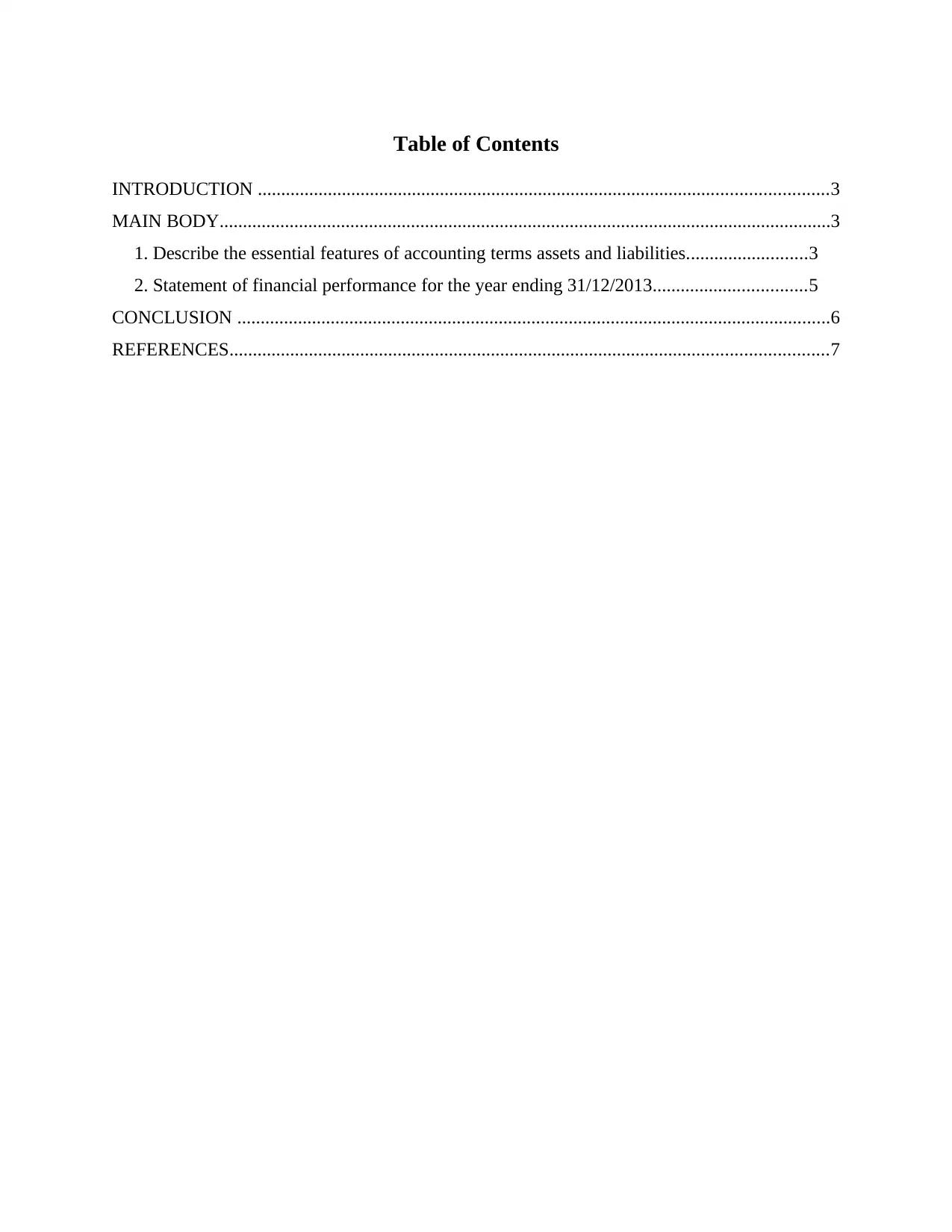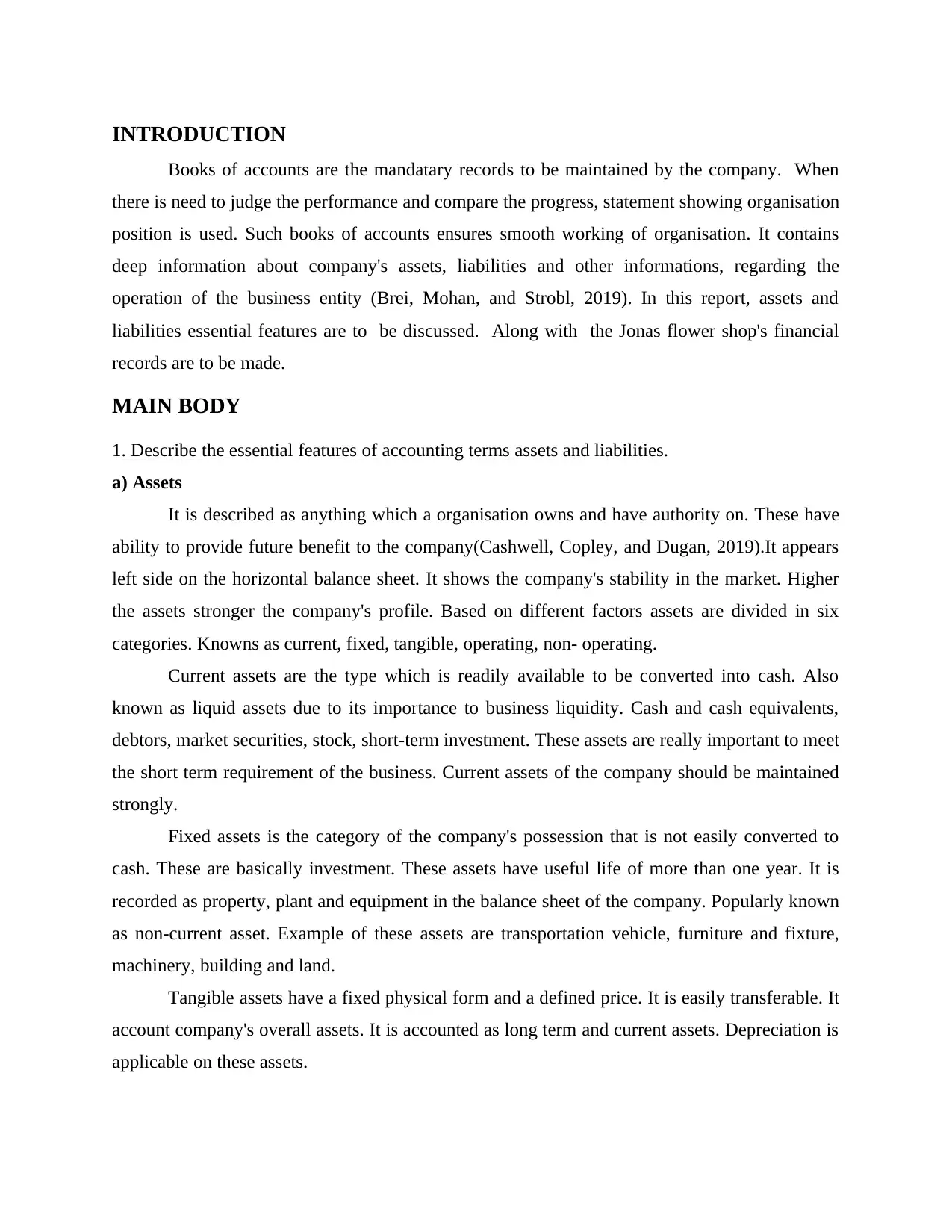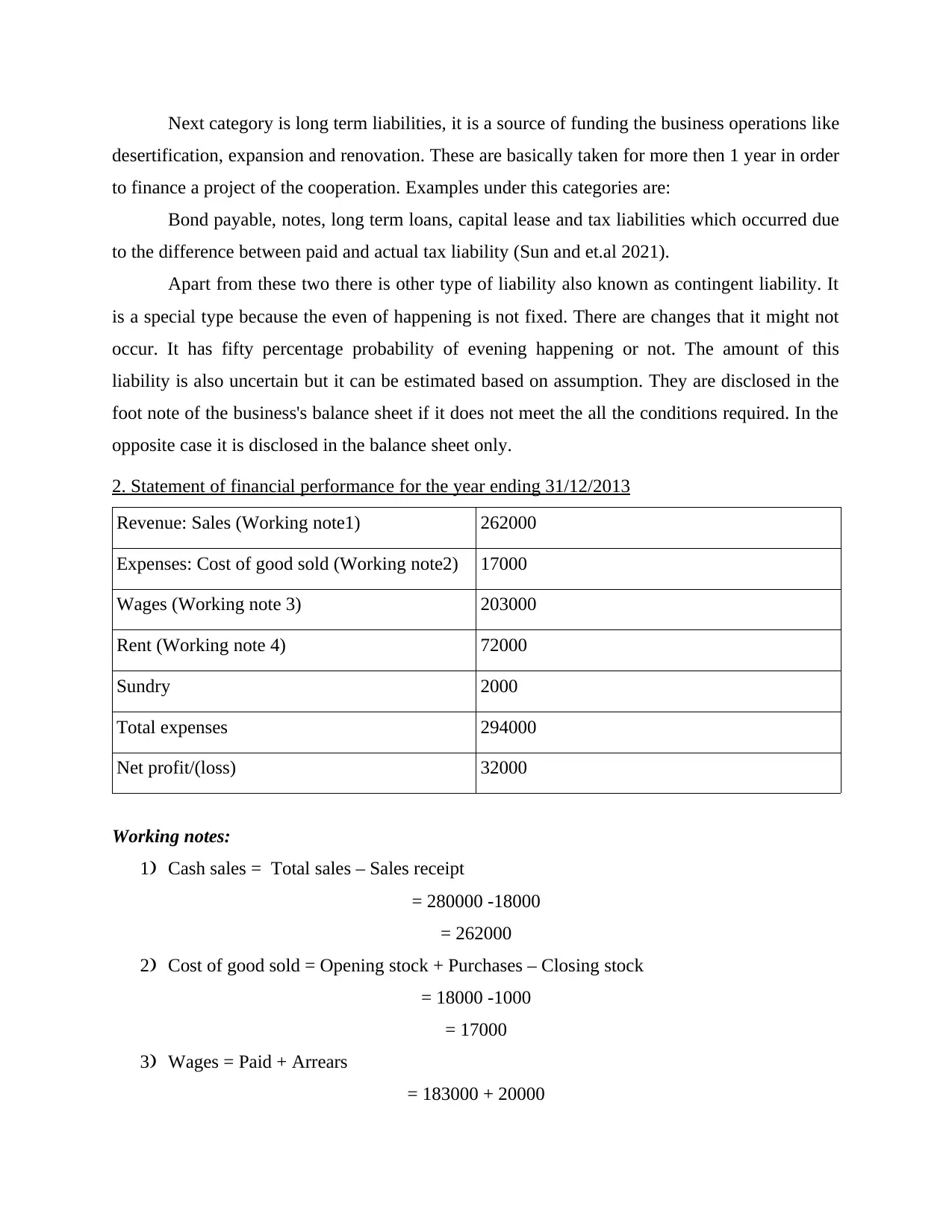Essential Features of Accounting Terms Assets and Liabilities
VerifiedAdded on 2023/06/09
|7
|1431
|215
AI Summary
This report discusses the essential features of accounting terms assets and liabilities. It also includes a statement of financial performance for the year ending 31/12/2013. The subject is Accounting and Business Decisions, and the course code and college/university are not mentioned. Get access to solved assignments, essays, dissertations and more at Desklib.
Contribute Materials
Your contribution can guide someone’s learning journey. Share your
documents today.

Accounting and business
decision
decision
Secure Best Marks with AI Grader
Need help grading? Try our AI Grader for instant feedback on your assignments.

Table of Contents
INTRODUCTION ..........................................................................................................................3
MAIN BODY...................................................................................................................................3
1. Describe the essential features of accounting terms assets and liabilities..........................3
2. Statement of financial performance for the year ending 31/12/2013.................................5
CONCLUSION ...............................................................................................................................6
REFERENCES................................................................................................................................7
INTRODUCTION ..........................................................................................................................3
MAIN BODY...................................................................................................................................3
1. Describe the essential features of accounting terms assets and liabilities..........................3
2. Statement of financial performance for the year ending 31/12/2013.................................5
CONCLUSION ...............................................................................................................................6
REFERENCES................................................................................................................................7

INTRODUCTION
Books of accounts are the mandatary records to be maintained by the company. When
there is need to judge the performance and compare the progress, statement showing organisation
position is used. Such books of accounts ensures smooth working of organisation. It contains
deep information about company's assets, liabilities and other informations, regarding the
operation of the business entity (Brei, Mohan, and Strobl, 2019). In this report, assets and
liabilities essential features are to be discussed. Along with the Jonas flower shop's financial
records are to be made.
MAIN BODY
1. Describe the essential features of accounting terms assets and liabilities.
a) Assets
It is described as anything which a organisation owns and have authority on. These have
ability to provide future benefit to the company(Cashwell, Copley, and Dugan, 2019).It appears
left side on the horizontal balance sheet. It shows the company's stability in the market. Higher
the assets stronger the company's profile. Based on different factors assets are divided in six
categories. Knowns as current, fixed, tangible, operating, non- operating.
Current assets are the type which is readily available to be converted into cash. Also
known as liquid assets due to its importance to business liquidity. Cash and cash equivalents,
debtors, market securities, stock, short-term investment. These assets are really important to meet
the short term requirement of the business. Current assets of the company should be maintained
strongly.
Fixed assets is the category of the company's possession that is not easily converted to
cash. These are basically investment. These assets have useful life of more than one year. It is
recorded as property, plant and equipment in the balance sheet of the company. Popularly known
as non-current asset. Example of these assets are transportation vehicle, furniture and fixture,
machinery, building and land.
Tangible assets have a fixed physical form and a defined price. It is easily transferable. It
account company's overall assets. It is accounted as long term and current assets. Depreciation is
applicable on these assets.
Books of accounts are the mandatary records to be maintained by the company. When
there is need to judge the performance and compare the progress, statement showing organisation
position is used. Such books of accounts ensures smooth working of organisation. It contains
deep information about company's assets, liabilities and other informations, regarding the
operation of the business entity (Brei, Mohan, and Strobl, 2019). In this report, assets and
liabilities essential features are to be discussed. Along with the Jonas flower shop's financial
records are to be made.
MAIN BODY
1. Describe the essential features of accounting terms assets and liabilities.
a) Assets
It is described as anything which a organisation owns and have authority on. These have
ability to provide future benefit to the company(Cashwell, Copley, and Dugan, 2019).It appears
left side on the horizontal balance sheet. It shows the company's stability in the market. Higher
the assets stronger the company's profile. Based on different factors assets are divided in six
categories. Knowns as current, fixed, tangible, operating, non- operating.
Current assets are the type which is readily available to be converted into cash. Also
known as liquid assets due to its importance to business liquidity. Cash and cash equivalents,
debtors, market securities, stock, short-term investment. These assets are really important to meet
the short term requirement of the business. Current assets of the company should be maintained
strongly.
Fixed assets is the category of the company's possession that is not easily converted to
cash. These are basically investment. These assets have useful life of more than one year. It is
recorded as property, plant and equipment in the balance sheet of the company. Popularly known
as non-current asset. Example of these assets are transportation vehicle, furniture and fixture,
machinery, building and land.
Tangible assets have a fixed physical form and a defined price. It is easily transferable. It
account company's overall assets. It is accounted as long term and current assets. Depreciation is
applicable on these assets.

Operating assets have a important role in the business operation of a company. It is those
things which are to be used everyday functions. Property, plant and equipment, inventory,
accounts receivable.
Non operating are not regarded as the business main operations part(Lane, and Milesi-Ferretti,
2018). These are mainly marketable securities, loans receivable, equipments and tools not in
use. Land that is not being used for anything related to business.
Intangible assets are those which can not physically seen or touch. But has a valuation in
the market. Example of this type is copyrights, patents, goodwill and trademark. These assets are
created and self made. Amortization is the term used for writing off their value over a period of
time.
b) Liabilities
It is everything that company is accountable for in the market. It is legal and restrictive
risk or obligation. In business terms they are defined as the responsibility to pay to the other
party on account of previous transaction(Mahtani, and Garg, 2018). Transaction can be
purchases, loan taken or any other event which has exchange of good and services involved.
Based on time period there are two type of liabilities current and non-current liabilities.
Obligations which need to be addressed within a period of 1 year are current type. Following are
the most common forms of this type.
Account payable: They are generally those bills which are unpaid to the suppliers of the
business entity. This covers most of the liability of the organisation.
Interest: Term amount which need to be paid on account of a debt or loan, and the due
date of this pay has been occurred but not been cleared yet. Outstanding expenses is the
term used for this account.
Income tax: This is type of current liabilities is statutory requirement. Owed to
government need to be paid within a year of the due date.
Bank account overdrafts: Short term loan category, when the organisation bank account
have insufficient funds.
Accrued: Expenses which has occurred but no document proving the expense have been
raised up till now.
Short-term loans: These are due before a period of one year.
things which are to be used everyday functions. Property, plant and equipment, inventory,
accounts receivable.
Non operating are not regarded as the business main operations part(Lane, and Milesi-Ferretti,
2018). These are mainly marketable securities, loans receivable, equipments and tools not in
use. Land that is not being used for anything related to business.
Intangible assets are those which can not physically seen or touch. But has a valuation in
the market. Example of this type is copyrights, patents, goodwill and trademark. These assets are
created and self made. Amortization is the term used for writing off their value over a period of
time.
b) Liabilities
It is everything that company is accountable for in the market. It is legal and restrictive
risk or obligation. In business terms they are defined as the responsibility to pay to the other
party on account of previous transaction(Mahtani, and Garg, 2018). Transaction can be
purchases, loan taken or any other event which has exchange of good and services involved.
Based on time period there are two type of liabilities current and non-current liabilities.
Obligations which need to be addressed within a period of 1 year are current type. Following are
the most common forms of this type.
Account payable: They are generally those bills which are unpaid to the suppliers of the
business entity. This covers most of the liability of the organisation.
Interest: Term amount which need to be paid on account of a debt or loan, and the due
date of this pay has been occurred but not been cleared yet. Outstanding expenses is the
term used for this account.
Income tax: This is type of current liabilities is statutory requirement. Owed to
government need to be paid within a year of the due date.
Bank account overdrafts: Short term loan category, when the organisation bank account
have insufficient funds.
Accrued: Expenses which has occurred but no document proving the expense have been
raised up till now.
Short-term loans: These are due before a period of one year.
Paraphrase This Document
Need a fresh take? Get an instant paraphrase of this document with our AI Paraphraser

Next category is long term liabilities, it is a source of funding the business operations like
desertification, expansion and renovation. These are basically taken for more then 1 year in order
to finance a project of the cooperation. Examples under this categories are:
Bond payable, notes, long term loans, capital lease and tax liabilities which occurred due
to the difference between paid and actual tax liability (Sun and et.al 2021).
Apart from these two there is other type of liability also known as contingent liability. It
is a special type because the even of happening is not fixed. There are changes that it might not
occur. It has fifty percentage probability of evening happening or not. The amount of this
liability is also uncertain but it can be estimated based on assumption. They are disclosed in the
foot note of the business's balance sheet if it does not meet the all the conditions required. In the
opposite case it is disclosed in the balance sheet only.
2. Statement of financial performance for the year ending 31/12/2013
Revenue: Sales (Working note1) 262000
Expenses: Cost of good sold (Working note2) 17000
Wages (Working note 3) 203000
Rent (Working note 4) 72000
Sundry 2000
Total expenses 294000
Net profit/(loss) 32000
Working notes:
1) Cash sales = Total sales – Sales receipt
= 280000 -18000
= 262000
2) Cost of good sold = Opening stock + Purchases – Closing stock
= 18000 -1000
= 17000
3) Wages = Paid + Arrears
= 183000 + 20000
desertification, expansion and renovation. These are basically taken for more then 1 year in order
to finance a project of the cooperation. Examples under this categories are:
Bond payable, notes, long term loans, capital lease and tax liabilities which occurred due
to the difference between paid and actual tax liability (Sun and et.al 2021).
Apart from these two there is other type of liability also known as contingent liability. It
is a special type because the even of happening is not fixed. There are changes that it might not
occur. It has fifty percentage probability of evening happening or not. The amount of this
liability is also uncertain but it can be estimated based on assumption. They are disclosed in the
foot note of the business's balance sheet if it does not meet the all the conditions required. In the
opposite case it is disclosed in the balance sheet only.
2. Statement of financial performance for the year ending 31/12/2013
Revenue: Sales (Working note1) 262000
Expenses: Cost of good sold (Working note2) 17000
Wages (Working note 3) 203000
Rent (Working note 4) 72000
Sundry 2000
Total expenses 294000
Net profit/(loss) 32000
Working notes:
1) Cash sales = Total sales – Sales receipt
= 280000 -18000
= 262000
2) Cost of good sold = Opening stock + Purchases – Closing stock
= 18000 -1000
= 17000
3) Wages = Paid + Arrears
= 183000 + 20000

= 203000
4) Rent = current period – advance payment
= 78000 – 6000
= 72000
CONCLUSION
In the report above it was conveyed that assets are the units that company owns which is
expected to give profits. Liabilities are the responsibility that are to be fulfilled by the
organisation. The rule of accounting says the assets and liabilities of the cooperation should tally
at the end. These need to be paid back to whom it is owned. Next, statement showing financial
statement was made. It was found that the firm was suffering loss.
4) Rent = current period – advance payment
= 78000 – 6000
= 72000
CONCLUSION
In the report above it was conveyed that assets are the units that company owns which is
expected to give profits. Liabilities are the responsibility that are to be fulfilled by the
organisation. The rule of accounting says the assets and liabilities of the cooperation should tally
at the end. These need to be paid back to whom it is owned. Next, statement showing financial
statement was made. It was found that the firm was suffering loss.

REFERENCES
Books and Journals
Brei, M., Mohan, P. and Strobl, E., 2019. The impact of natural disasters on the banking sector:
Evidence from hurricane strikes in the Caribbean. The Quarterly Review of Economics
and Finance, 72. pp.232-239.
Cashwell, K., Copley, P. and Dugan, M., 2019. Using ratio analysis to manage not-for-profit
organizations. The CPA Journal, 89(5).pp.52-57.
Lane, P.R. and Milesi-Ferretti, G.M., 2018. The external wealth of nations revisited:
international financial integration in the aftermath of the global financial crisis. IMF
Economic Review, 66(1).pp.189-222.
Mahtani, U.S. and Garg, C.P., 2018. An analysis of key factors of financial distress in airline
companies in India using fuzzy AHP framework. Transportation Research Part A:
Policy and Practice, 117.pp.87-102.
Sun, J.,and et.al 2021. Multi-class financial distress prediction based on support vector machines
integrated with the decomposition and fusion methods. Information
Sciences, 559.pp.153-170.
Books and Journals
Brei, M., Mohan, P. and Strobl, E., 2019. The impact of natural disasters on the banking sector:
Evidence from hurricane strikes in the Caribbean. The Quarterly Review of Economics
and Finance, 72. pp.232-239.
Cashwell, K., Copley, P. and Dugan, M., 2019. Using ratio analysis to manage not-for-profit
organizations. The CPA Journal, 89(5).pp.52-57.
Lane, P.R. and Milesi-Ferretti, G.M., 2018. The external wealth of nations revisited:
international financial integration in the aftermath of the global financial crisis. IMF
Economic Review, 66(1).pp.189-222.
Mahtani, U.S. and Garg, C.P., 2018. An analysis of key factors of financial distress in airline
companies in India using fuzzy AHP framework. Transportation Research Part A:
Policy and Practice, 117.pp.87-102.
Sun, J.,and et.al 2021. Multi-class financial distress prediction based on support vector machines
integrated with the decomposition and fusion methods. Information
Sciences, 559.pp.153-170.
1 out of 7
![[object Object]](/_next/static/media/star-bottom.7253800d.svg)




